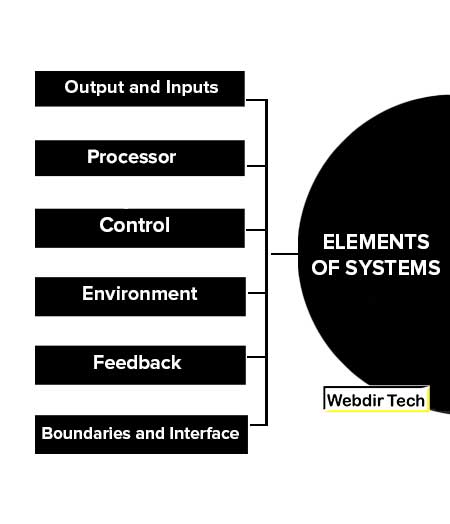Elements of Systems
The following are considered the elements of system in terms of information systems:
- Output and Inputs
- Processor
- Control
- Environment
- Feedback
- Boundaries and Interface

Output and Inputs
A major objective of a system is to produce an output that has value to its user. Whatever the nature of the output (goods, services, or information), It must be in line with the expectations of the intended user. Inputs are the elements (material, human resources, and information) that enter the system for processing.
Output is the outcome of processing. A system feeds on input to produce output in much the same way that a business brings in human, financial, and martial resources to produce goods and services. It is important to point out here that determining the output is the first step in specifying the nature, amount, and regularity of the input needed to operate a system.
For example, In the system analysis, the first concern is to determine the user’s requirements of a proposed computer system that is, the specification of the output that the computer is expected to provide for meeting user requirements.
Processor
The processor is the element of a system that involves the actual transformation of input into output. It is the operational component of a system. Processors may modify the input totally or partially, depending on the specification of the output.
This means that as the output specifications change so does the processing. In some cases, input is also modified to enable the processor to handle the transformation.
Control
The control element guides the system. It is the decision–making subsystem that controls the pattern of activities governing input, processing, and output. In an organizational context, management as a decision–making body controls the inflow, handling, and outflow of activities that affect the welfare of the business.
In a computer system, the operating system and accompanying software influence the behavior of the system. Output specifications determine what and how much input is needed to keep the system in balance.
In systems analysis, knowing the attitudes of the individual who controls the area for which a computer is being considered can make a difference between the success and failure of the installation. Management support is required for securing control and supporting the objective of the proposed change.
Environment
The environment is the “suprasystem” within which an organization operates. It is the source of external elements that impinge on the system. In fact, it often determines how a system must function.
For example, the organization’s environment, consisting of vendors, competitors, and others, may provide constraints and, consequently, influence the actual performance of the business.
Feedback
Control in a dynamic system is achieved by feedback. Feedback measures output against a standard in some form of cybernetic procedure that includes communication and control. The output information is fed back to the input and/or to management (Controller) for deliberation. After the output is compared against performance standards, changes can result in the input or processing and consequently, the output.
Feedback may be positive or negative, routing or informational. Positive feedback reinforces the performance of the system. It is routine. Negative feedback generally provides the controller with information for action. In systems analysis, feedback is important in different ways.
During analysis, the user may be told that the problems in a given application verify the initial concerns and justify the need for change. Another form of feedback comes after the system is implemented. The user informs the analyst about the performance of the new installation. This feedback often results in enhancements to meet the user’s requirements.
Boundaries and Interface
A system should be defined by its boundaries – the limits that identify its components, processes, and interrelationship when it interfaces with another system. For example, a teller system in a commercial bank is restricted to the deposits, withdrawals, and related activities of customers’ checking and savings accounts.
It may exclude mortgage foreclosures, trust activities, and the like. Each system has boundaries that determine its sphere of influence and control. For example, in an integrated banking–wide computer system design, a customer who has a mortgage and a checking account with the same bank may write a check through the “teller system” to pay the premium that is later processed by the “mortgage loan system.”
Recently, system design has been successful in allowing the automatic transfer of funds from a bank account to pay bills and other obligations to creditors, regardless of distance or location. This means that in systems analysis, knowledge of the boundaries of a given system is crucial in determining the nature of its interface with other systems for successful design.
FAQ Related to Elements of Systems
What are the elements of system?
The following are the elements of system:
1. Output and Inputs
2. Processor
3. Control
4. Environment
5. Feedback
6. Boundaries and Interface.
